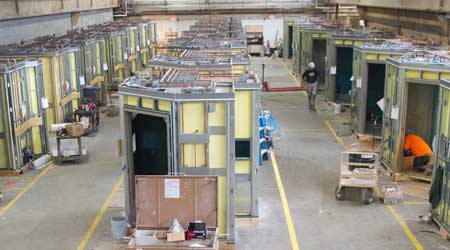How Modular Healthcare Facilities Aided Pandemic Response
Because they can be built quickly, modular healthcare facilities are being used all over the world as surge capacity for COVID-19 patients.
Modular construction allows hospitals and healthcare entities to quickly increase the number of patients they can care for during construction projects or during pandemic situations. Hospitals and healthcare facilities are not equipped to handle a large influx of patients in a very short timeframe. Hospitals maintain enough bed space for a typical patient load and do not have a large amount of spare patient beds — the maintenance cost for having a large amount of unused patient bed space just doesn’t make sense. A better solution is to provide a means to rapidly scale up the number of available patient beds utilizing prefabricated units or being able to quickly construct new facilities. In a situation like a pandemic, modular construction’s speed is its biggest advantage.
During the initial COVID-19 outbreak, in Wuhan, China, we saw the construction of large facilities to house infected patients constructed in just 10 days. Although it is unclear if these facilities would meet the standards of typical hospital construction seen in the United States and other countries, it is impressive to see such a feat of engineering and construction. A modularly constructed hospital, built to the same codes and standards as typical hospitals, may not be able to match the speed of construction seen in China, but certainly offers a more efficient solution than typical construction methods may be able to provide. Patient rooms could be fabricated off-site, while foundations and structural steel work are being performed on site. The prefabricated patient rooms are then brought on site, positioned and installed, and connected to building central infrastructure such as HVAC, domestic water, sanitary, emergency power and electrical system, and sprinkler systems.
Challenges still to overcome
Healthcare is the market segment poised for the biggest increase in the use of modular and prefabricated construction over the next three years, according to Dodge Data & Analytics. However, there are still challenges in implementing its use in the healthcare market moving forward. Based on a recent Dodge study, healthcare facilities accounted for 24 percent of building types using permanent modular construction. It is expected to decrease over the next three years to 14 percent, according to the study. Healthcare and public buildings are the only segments in which modular construction is expected to contract over the next three years. All other market segments are expected to increase.
According to Dodge, the biggest challenge noted for modular construction is lack of building owner interest in the modular approach. Without the confidence of building owners to use modular construction, it is unlikely that it will become more common. The same study also noted that familiarity with the process, by architects, engineers, contractors, and skilled trades, is another obstacle. This suggests that building owners are not being properly educated about the benefits of modular construction. Instead, they are moving forward with traditional construction methods even when a better approach may be available.
The same study noted that having properly trained workforce to perform prefabrication or install modular components is another significant hurdle. The construction industry, from general contractors to specific trades, will all need to improve their capabilities to perform prefabrication of components and modular building construction. Trade groups, such as the Modular Building Institute, will need to increase their outreach and training so contractors have the information they need to properly implement prefabrication and modular construction techniques and bring them to the market. Architects and engineers will need to work with contractors to help standardize components and construction methods to help ensure a high-quality product is fabricated before being moved to the project site.
In the case of prefabricated units, contractors will need to have the necessary space for fabrication and storage, prior to installation at the project site. This requires a significant investment that contractors will need to make. Depending on the size of the project and the anticipated schedule, large areas may be necessary. This should also allow for the contractors to reduce their overall presence on project sites as lay down area sizes and construction limits can be reduced.
The ability to pre-manufacture building components and assemble them on site can potentially reduce construction times for new facilities and reduce costs. The ability to quickly construct facilities could be critical in the event of another pandemic. However, unless building owners are educated — and building construction trades are equipped to execute such projects effectively through training and education — modular construction is not likely to gain traction as an effective construction method in the healthcare market.
Gregory Hudson, PE, is a mechanical project manager with RMF Engineering. His experience encompasses the analysis and design of HVAC, plumbing, and fire protection systems serving health care, educational, laboratory and commercial facilities. Additionally, he is a certified Healthcare Facility Design Professional through ASHRAE.
Related Topics:











